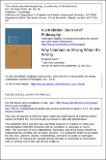Files in this item
Why coercion is wrong when it’s wrong
Item metadata
| dc.contributor.author | Sachs, Benjamin Alan | |
| dc.date.accessioned | 2013-04-04T13:31:02Z | |
| dc.date.available | 2013-04-04T13:31:02Z | |
| dc.date.issued | 2013 | |
| dc.identifier | 29951537 | |
| dc.identifier | 024c44bb-b6cb-4769-8011-9276b48208df | |
| dc.identifier | 84876112799 | |
| dc.identifier.citation | Sachs , B A 2013 , ' Why coercion is wrong when it’s wrong ' , Australasian Journal of Philosophy , vol. 91 , no. 1 , pp. 63-82 . https://doi.org/10.1080/00048402.2011.646280 | en |
| dc.identifier.issn | 0004-8402 | |
| dc.identifier.other | ORCID: /0000-0002-2307-7620/work/69029273 | |
| dc.identifier.uri | https://hdl.handle.net/10023/3466 | |
| dc.description.abstract | It is usually thought that wrongful acts of threat-involving coercion are wrong because they involve a violation of the freedom or autonomy of the targets of those acts. I argue here that this cannot possibly be right, and that in fact the wrongness of wrongful coercion has nothing at all to do with the effect such actions have on their targets. This negative thesis is supported by pointing out that what we say about the ethics of threatening (and thus the ethics of coercion) constrains what we can say about the ethics of warning and offering. Importantly, our favoured explanation of the wrongness of certain kinds of threatening should not commit us to condemning as wrong parallel cases of warning and offering. My positive project is to show how this can be done. I defend the claim that wrongful coercion is nothing more than the issuing of a conditional threat to do wrong, and that an agent's issuing of a conditional threat to do wrong is wrong because it constitutes motivation for that agent to adopt the announced intention to do wrong. The idea of explaining the wrongness of wrongful coercion in this way has gone unnoticed because we have thus far been mistaken about what a threat is. In this essay I present my moral analysis of coercion only after presenting a careful descriptive analysis of threats. On my view, it is essential to a threat that the announced intention is one that the agent does not possess before announcing it. This analysis makes it possible to elucidate the descriptive differences between threats, warnings and offers, which sets up the later project of elucidating the moral differences between them. | |
| dc.format.extent | 20 | |
| dc.format.extent | 366808 | |
| dc.language.iso | eng | |
| dc.relation.ispartof | Australasian Journal of Philosophy | en |
| dc.rights | (c) 2013 Australasian Association of Philosophy. This is an Open Access article. For full terms and conditions of use, see: http://www.tandfonline.com/page/ terms-and-conditions esp. Part II. Intellectual property and access and license types, § 11. (c) Open Access Content | en |
| dc.subject | Coercion | en |
| dc.subject | Threat | en |
| dc.subject | Warning | en |
| dc.subject | Offer | en |
| dc.subject | Intention | en |
| dc.subject | BJ Ethics | en |
| dc.subject.lcc | BJ | en |
| dc.title | Why coercion is wrong when it’s wrong | en |
| dc.type | Journal article | en |
| dc.contributor.institution | University of St Andrews.Philosophy | en |
| dc.identifier.doi | 10.1080/00048402.2011.646280 | |
| dc.description.status | Peer reviewed | en |
This item appears in the following Collection(s)
Items in the St Andrews Research Repository are protected by copyright, with all rights reserved, unless otherwise indicated.

